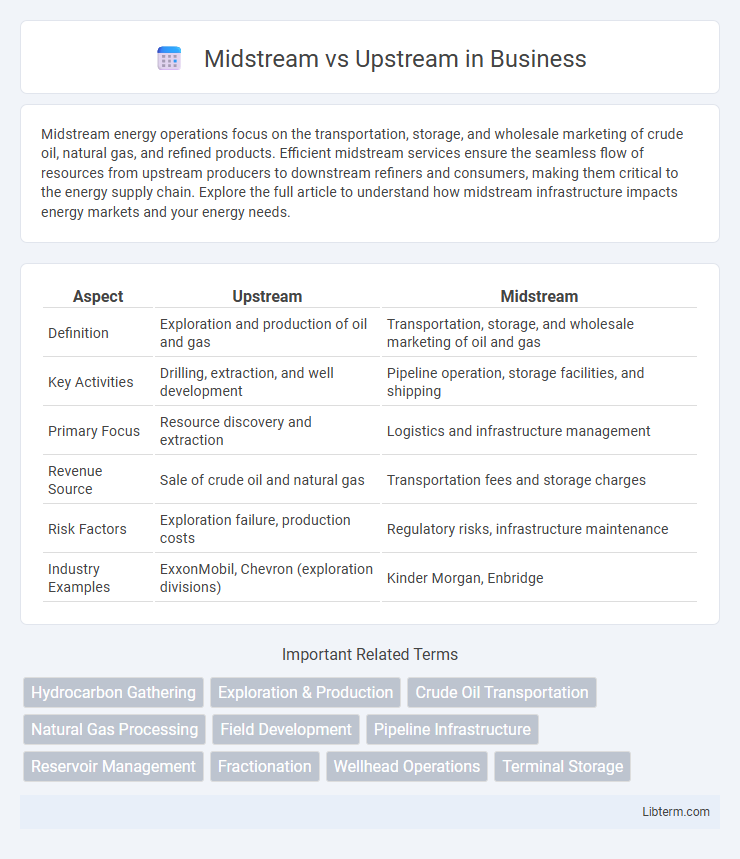Midstream energy operations focus on the transportation, storage, and wholesale marketing of crude oil, natural gas, and refined products. Efficient midstream services ensure the seamless flow of resources from upstream producers to downstream refiners and consumers, making them critical to the energy supply chain. Explore the full article to understand how midstream infrastructure impacts energy markets and your energy needs.
Table of Comparison
| Aspect | Upstream | Midstream |
|---|---|---|
| Definition | Exploration and production of oil and gas | Transportation, storage, and wholesale marketing of oil and gas |
| Key Activities | Drilling, extraction, and well development | Pipeline operation, storage facilities, and shipping |
| Primary Focus | Resource discovery and extraction | Logistics and infrastructure management |
| Revenue Source | Sale of crude oil and natural gas | Transportation fees and storage charges |
| Risk Factors | Exploration failure, production costs | Regulatory risks, infrastructure maintenance |
| Industry Examples | ExxonMobil, Chevron (exploration divisions) | Kinder Morgan, Enbridge |
Understanding the Oil and Gas Value Chain
Upstream activities in the oil and gas value chain involve exploration and production, including drilling wells and extracting crude oil or natural gas from underground reservoirs. Midstream operations focus on the transportation, storage, and wholesale marketing of hydrocarbons through pipelines, tankers, and storage facilities, ensuring efficient delivery from production sites to refineries. Understanding the distinction between upstream and midstream segments is essential for optimizing supply chain management and investment strategies in the energy sector.
Defining Upstream Operations
Upstream operations in the oil and gas industry encompass exploration, drilling, and production activities aimed at locating and extracting hydrocarbons from reservoirs beneath the earth's surface. These processes involve geological surveys, seismic data analysis, well drilling, and managing production wells to maximize resource recovery. Upstream is critical for identifying viable reserves and initiating the supply chain that feeds into midstream transportation and downstream refining sectors.
Key Activities in Upstream Sector
The upstream sector in the oil and gas industry primarily involves exploration and production activities, including geological surveys, seismic data analysis, and drilling of exploratory wells to locate hydrocarbon reserves. Key activities also encompass reservoir engineering, well completion, and extraction of crude oil and natural gas from underground reservoirs. These operations are critical for identifying and developing viable energy resources before they move to midstream processing and transportation.
What is Midstream in Oil and Gas?
Midstream in oil and gas refers to the segment that involves the transportation, storage, and wholesale marketing of crude oil, natural gas, and refined products. Key components include pipelines, railways, storage facilities, and processing plants that move hydrocarbons from production sites to refineries or distribution centers. This stage bridges upstream exploration and production with downstream refining and retail, ensuring efficient supply chain management in the energy sector.
Main Functions of the Midstream Sector
The midstream sector primarily handles the transportation, storage, and wholesale marketing of crude oil, natural gas, and refined products. Key functions include operating pipelines, storage facilities, and shipping terminals to efficiently move hydrocarbons from production sites to refineries and distribution centers. Midstream activities ensure the continuous flow and safe handling of energy resources, bridging the gap between upstream exploration and downstream refining processes.
Major Differences Between Upstream and Midstream
Upstream activities focus on exploration and production of oil and natural gas, involving seismic surveys, drilling, and extraction of raw hydrocarbons. Midstream operations handle the transportation, storage, and wholesale marketing of crude oil, natural gas, and refined products, utilizing pipelines, tankers, and storage facilities. The key difference lies in upstream dealing with resource discovery and extraction, while midstream emphasizes logistics and infrastructure for moving and storing hydrocarbons.
Technology and Innovation in Upstream vs Midstream
Upstream technology focuses on advanced exploration and production techniques such as 3D seismic imaging, automated drilling systems, and real-time data analytics to optimize resource extraction and enhance safety. Midstream innovation emphasizes pipeline monitoring systems, corrosion detection technologies, and digital twins to ensure efficient, reliable transportation and storage of hydrocarbons. Integration of IoT and AI across both sectors improves operational efficiency but upstream remains more research-intensive due to subsurface complexity.
Economic Impact of Each Segment
Midstream operations, including transportation, storage, and wholesale marketing of crude or refined petroleum products, drive significant economic activity by providing essential infrastructure that ensures supply chain efficiency and stability. Upstream activities, encompassing exploration and production, generate substantial revenue through resource extraction, directly impacting local economies with job creation and capital investments but facing volatility due to fluctuating commodity prices. The balance between upstream capital expenditures and midstream infrastructure investments shapes regional economic development, influencing market accessibility and long-term energy security.
Challenges Facing Upstream and Midstream Industries
Upstream industry challenges include exploration risks, fluctuating oil prices, and rising operational costs, impacting the profitability and sustainability of extracting hydrocarbons. Midstream sector struggles with aging infrastructure, regulatory compliance, and the need for pipeline integrity and safety, which affect the efficient transportation and storage of oil and gas. Both sectors face increasing pressure to adopt digital technologies and reduce environmental impact amid stringent climate policies.
Future Trends for Upstream and Midstream Operations
Emerging technologies like AI, IoT, and digital twins are driving efficiency and predictive maintenance in upstream oil and gas exploration and production, optimizing resource extraction and reducing operational costs. In midstream operations, the integration of blockchain and advanced data analytics enhances supply chain transparency and pipeline monitoring, ensuring safer and more efficient transportation of hydrocarbons. Both segments are increasingly adopting renewable energy sources and carbon capture technologies to meet stringent environmental regulations and transition towards sustainable energy futures.
Midstream Infographic

 libterm.com
libterm.com